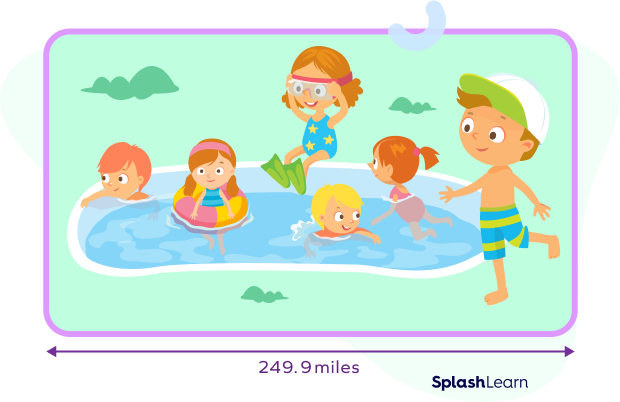What is Rounding?
Rounding refers to converting a particular number to an easy number. The rounded number is not exact but an estimate of the given number.
 Begin here
Begin here
Purpose of Rounding
Usually, we round numbers for:
- Making calculations easy.
- Making the numbers easy to understand and remember.
Related Worksheets
Applications of Rounding

Estimation: We use rounding to guess the most appropriate answer. Rounding is the process of estimation.
For example, Oolzoo wants to buy ice-creams worth $\$97$. He can estimate the amount to the nearest tens and give $\$100$ to the storekeeper, who will return $\$3$ to him.
Estimation helps us calculate easily.
Step-by-Step Process to Round to the Nearest Tens
We can follow the given steps for rounding whole numbers to the nearest tens:
Step 1: We look at the number we want to round.
Step 2: To round off numbers to the nearest tens, we mark the digits in the ones column and tens column.
Step 3: (i) If the digit in the ones column is between 0 and 4 (i.e., if the digit is less than 5), we replace this digit with 0. This is called rounding down.
(ii) If the digit in the ones column is between 5 and 9 (i.e., if the digit is greater than 4 but less than 10), we replace this digit with 0 and increase the digit in the tens column by 1. This is called rounding up.
Note: If the given number has any digit to the right of the ones column, we remove them.
The number we get after rounding up or rounding down and removing any digit on the right of the ones column is our answer.
Example 1: Round 523 to the nearest ten.
Step 1: We must round the number 523 to the nearest ten.
Step 2: To round to the nearest tens, we mark the digits in the ones and tens column. In this number, we see that the digit 3 is in the ones column and the digit 2 is in the tens column.
Step 3: Since the digit in the ones column (i.e., 3) is between 0 and 4, we replace this digit with 0. This means we replace 3 with 0.
As no digit exists on the right of the ones column, we don’t have to remove anything.
So, the number we get after rounding 523 to the nearest ten is 520.
Example 2: Round 147.32 to the nearest tens.
Step 1: We have to round the number 147.32 to the nearest ten.
Step 2: To round to the nearest tens, we mark the digits in the ones and tens column.In this number, we see that the digit 7 is in the ones column and the digit 4 is in the tens column.
Step 3: Since the digit in the ones column (i.e., 7) is between 5 and 9, we replace this digit with 0. This means we replace 7 with 0. We then increase the digit in the tens column by 1. This means increasing 4 by 1 and getting 5 in the tens column.
Note: In 147.32, there are two digits on the right of the ones column (i.e., 3 and 2). We remove them.
So, after rounding 147.32 to the nearest ten, the number we get is 150.
Example 3: Eddie is 169 cm tall. Write his height to the nearest tens.

Step 1: We have to round the number 169 to the nearest ten.
Step 2: To round to the nearest tens, we mark the digits in the ones and tens column.In this number, we see that the digit 9 is in the ones column and the digit 6 is in the tens column.
Step 3: Since the digit in the ones column (i.e., 9) is between 5 and 9, we replace this digit with 0. This means we replace 9 with 0. We then increase the digit in the tens column by 1. This means we increase 6 by 1 and get 7 in the tens column.
(As no digit exists on the right of the ones column, we don’t have to remove anything.)
So, after rounding 169 to the nearest ten, the number we get is 170.
Exception:
Example 4: Round the number 195.278 to the nearest tens.
Step 1: We have to round the number 195.278 to the nearest ten.
Step 2: To round to the nearest tens, we mark the digits in the ones and tens column.In this number, we see that digit 5 is in the ones column and digit 9 is in the tens column.
Step 3: Since the digit in the ones column (i.e., 5) is between 5 and 9, we replace this digit with 0. This means we replace 5 with 0. We then increase the digit in the tens column by 1. This means we increase 9 by 1 and get 10. We keep the 0 in the tens column and carry 1 to the hundreds column. Here, we already have 1 in the hundreds column. We add the carry 1 to this 1 and get 2.
Note: In 195.278, there are three digits on the right of the ones column (i.e., 2, 7, and 8). We remove them.
So, after rounding 195.278 to the nearest ten, the number we get is 200. Since we have moved up the number to the nearest ten, we call it rounding up.
Example 5: A park measures 249.9 miles in length. How long is the park to the nearest 10, in miles?

Step 1: We have to round the number 249.9 to the nearest ten.
Step 2: To round to the nearest tens, we mark the digits in the ones and tens column.In this number, we see that digit 9 is in the ones column and digit 4 is in the tens column.
Step 3: Since the digit in the ones column (i.e., 9) is between 5 and 9, we replace this digit with 0. This means we replace 9 with 0. We then increase the digit in the tens column by 1. This means we increase 4 by 1 and get 5 in the tens column.
Note: In 249.9, there is a digit on the right of the ones column (i.e., 9). We remove it.
So, after rounding 249.9 to the nearest ten, the number we get is 250.
Note: Since we have moved up the number to the nearest ten, we call it rounding up.
Fun Fact
| – Around the world, a few retail outlets set prices like 99,199, 0.99,9.99, etc. This is done because generally, people read from left to right, striking the first number in our heads. Because of this, we tend to think that the prices are lower. |
Solved Examples on Rounding To The Nearest Tens
Example 1: Round 105 to the nearest tens.
Solution: To round to the nearest tens, we mark the digits in the ones and tens column. In the number 105, we have 5 in the ones column and 0 in the tens column. Since the digit in the ones column (i.e., 5) is between 5 and 9, we replace this digit with 0. We then increase the digit in the tens column by 1. This means we increase 0 by 1 and get 1 in the tens column.
So, after rounding 105 to the nearest tens, the number we get is 110.
Example 2: Round 860 to the nearest tens.
Solution: To round to the nearest tens, we mark the digits in the ones and tens column.In the number 860, we have 0 in the ones column and 6 in the tens column. Since the digit in the ones column (i.e., 0) is between 0 and 4, we replace this digit with 0. But here, 0 already exists in the ones column. So, no change occurs in the ones column. This means we get the same number, 860, after following the steps of rounding off.
So, 860 rounded to the nearest tens remains the same, i.e., 860.
Example 3: The average height of students in a college is 69.5 inches. Write the height rounded to the nearest tens.
Solution: To round to the nearest tens, we mark the digits in the ones and tens column. In the number 69.5, we have 9 in the ones column and 6 in the tens column. Since the digit in the ones column (i.e., 9) is between 5 and 9, we replace this digit with 0. We then increase the digit in the tens column by 1. This means we increase 6 by 1 and get 7 in the tens column.
Now we remove the digit on the right of the ones column (i.e., 5).
So, the average height of 69.5 inches rounded to the nearest tens is 70 inches.
Practice Problems on Rounding To The Nearest Tens
Rounding To The Nearest Tens - Definition With Examples
The price of a book is $743. What is the price of the book rounded to the nearest tens?
To round to the nearest tens, we check the digit in the ones column of 743. The digit in the ones column is 3. Since 3 lies between 0 and 4, we replace it with 0. This gives us the number 740.
Round 3596 to the nearest tens.
To round to the nearest tens, we mark the digits in the ones and tens column.The number 3596 has 6 in the ones column and 9 in the tens column. Since the digit in the ones column (i.e., 6) is between 5 and 9, we replace this digit with 0. We then increase the digit in the tens column (i.e., 9) by 1 and get 10. We keep the 0 in the tens column and carry 1 to the hundreds column. Here, we already have 5 in the hundreds column. We add the carry 1 to this 5 and get 6. This gives us the number 3600.
James drove 347.8 miles to reach his father’s house. Round off the distance to the nearest tens.
The distance traveled is 347.8 miles. To round to the nearest tens, we mark the digits in the ones and tens column. We have 7 in the ones column and 4 in the tens column. Since 7 lies between 5 and 9, we replace it with 0 and increase the digit in the tens column by 1. This means we increase 4 by 1 and get 5 in the tens column.
Now we remove the digit on the right of the ones column (i.e., 8). This gives us the number 350.
Frequently Asked Questions on Rounding To The Nearest Tens
Can a number remain the same even after rounding to the nearest tens?
Yes. Any number with 0 in the ones column will remain the same even after rounding to the nearest tens.
Is it necessary to learn place value for rounding off numbers?
Yes. While rounding off, you will have to deal with digits in the hundreds column, tens column, ones column, etc. Knowing about place value will help you do so.
What is rounded up and rounded down?
When we round off a number, if the rounded-off value is greater than the original value, we say it is rounded up. If the rounded-off value is less than the original value, it is said to be rounded down.





















